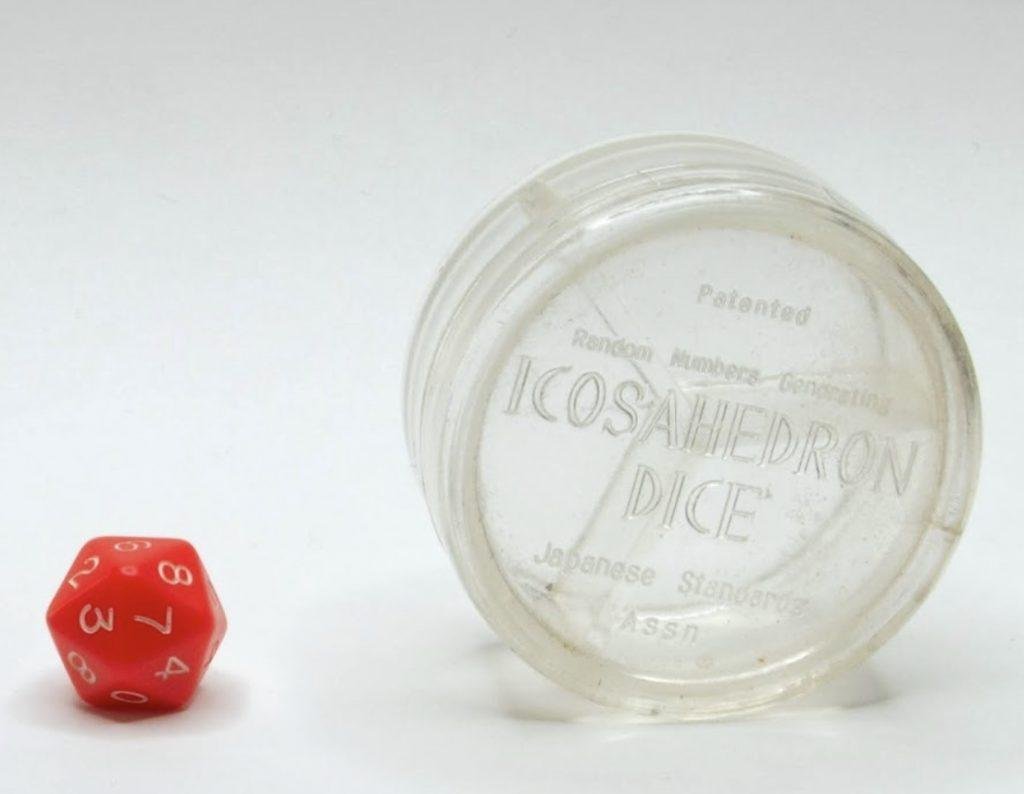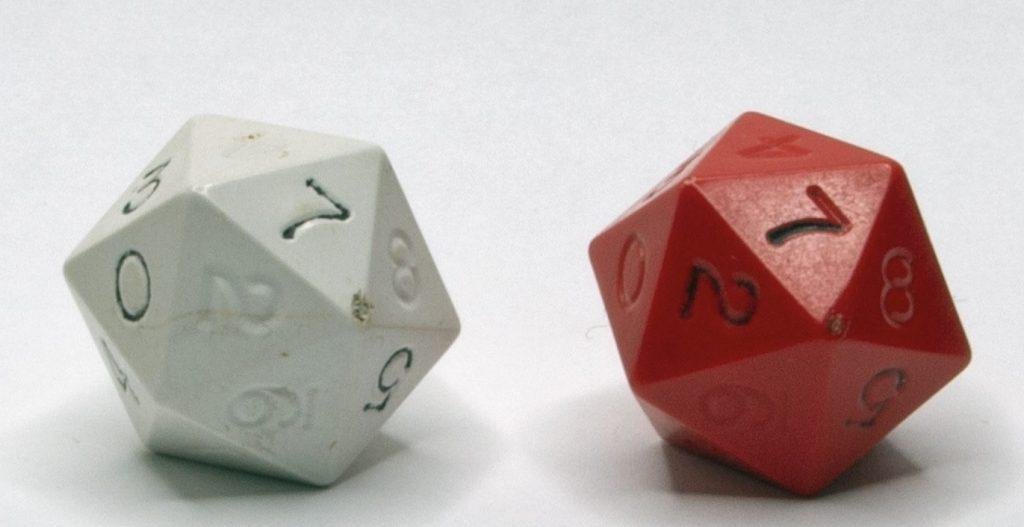The History of Polyhedral Dice In Board Games
Does Gary Gygax have a legacy in board gaming beyond Dungeons & Dragons as The Godfather of Polyhedral Dice? It seemed to me that the usage of polyhedral dice in board gaming basically began with the original Holmes 5 pieces Polyhedral set issued with Dungeons & Dragons Basic Sets in 1977. This set include a yellow d4, an orange d6, a green d8, a blue d12, and a white d20(early ones had the numbers 0-9 twice on them, the concept of printing the values 10-20 on the dice face would come later).

Read More:
Unearthing more polyhedral dice history – The History of Polyhedral Dice Part II
There were sets that pre-date this famous set. In 1972, Creative Publications made a polyhedral set that looks very close to the Holmes set, with the exception of a pink d6. The d6 would take on a pink hue and the dice were not all that sturdy. These early sets can fetch close to $1000 or more.

The earliest d20 I can find was made in Japan in the 1960’s by Japanese Standards Association(JSA). The d20s were produced in Japan and used as quality control devices in the late 60’s. They were sold as a set of three in red-yellow-blue and numbered 0-9 twice on each die. Wargamers adapted it for gaming use.

The next entry on the d20 list appears around 1970 from the Bristol Wargaming Society. These dice were imported into the UK by a man named Lou Zocchi. Tractics(1971), a tank war game, includes a d20 in its later releases. Most likely a Zocchi or TSR d20. Zocchi would release a percentile set (2d20 number 0-9 twice) in 1975, and then a full set in around 1978(d4, d8 d12, d20). Polyhedral Set also released a set of inked and non-inked polyhedral dice(d4, d8 d12, d20) in 1976.

That traces the history of d4, d6, d8, d12, d20 in board gaming. Which only leaves d10 as the last major mystery to solve. In 1980, Gamescience ran advertisements in the back of gaming magazines touting their latest invention, the d10 polyhedral. In 1982, The Armory invented the d30. Then in 1985, Lou Zocchi invented the d100.
In the end I am going to split up the credit for polyhedral dice in board gaming to three men:
Don Lowry – First to include a d20 in his game Tratics, and one of the first distributors of 5 piece polyhedral sets.
Lou Zocchi – Importer, innovator, and champion of polyhedral dice.
Gary Gygax – The man who fully integrated a set of polyhedral dice into game design and popularized them through D&D.
First Board Game To Include The Polyhedral
d4 – The Royal Game of UR (Mesopotamia)
d6 – Backgammon (Iran)
d8 – Dungeons & Dragons* (See Libre de Los Juegos below)
d10 – Dungeons & Dragons
d12 – Dungeons & Dragons
d20 – Tractics
d30 – Scattergories
Historical Timeline of Polyhedral Dice
Pre 5000 BC – d6
The first d6 may have been prehistoric times. Knucklebones was a prehistoric form of gambling. Trying to put a firm date on a cube you could roll would seem difficult at best.
3500 BC – d4
To get the true historical date for the first d4 we would probably need to go back to the time of The Royal Game of Ur, roughly 5000 years or so. Two d4 were used in Ur to move the pieces on the board.
300BC – 200 AD – d20 & d12
Surprisingly, both the Egyptians and the Romans knew of and made d20 dice. The Egyptian probably had it first a few hundred years BC. The Romans had it by 2nd century AD. That would put d20 dice at around 2000 years old. Where the Egyptians really trump the Romans is that they also had knowledge of the d12 die. Most likely used for divine purposes, the d12 would allow representation of the heavens and moons(months).
1283 AD – d8s
The Libro de los Juegos (“Book of games”)
The text is a treatise that addresses the playing of three games and includes the use of both seven- and eight-sided dice in order to speed up play in chess variants. The invention of these dice is credited to Alfonso X of Castile
1898: d10
U.S. Patent# 614,524: Poker “Dice”
Issued November 22, 1898 to J.O. Yardley as “Game Apparatus.” Not quite dice. More like barrels with sides leading to weighted results. But it did have 10 sides and you could roll it.
1900: d12
U.S. Patent# 645,112: Dice
Issued March 13, 1900 to V. Mapes is actually a patent for “Poker Dice” with various suits and numbers interspersed over five total dice in the game.
1904 – d10
U.S. Patent#809,293: 10 Sided Die
Albert Friedenthal files for a 10-sided die.
1912: d4
U.S. Patent# 1,030,554: “Skeletal d4”
Issued June 25, 1912 to S.E. Wharton for “a game.” This version is not the flat-faced version commonly seen today.
1917: d8
U.S. Patent# 1,223,365: “Rhomboid” d8
Issued April 24, 1917 to E.N. Breitung as simply a “die.” This is a strange rhomboidal die with pips instead of numbers. Probably not a fair d8 and not the one we know today.
1925: d20
U.S. Patent# 1,555,447: d20 Letters
Issued Sept. 29, 1925 to H. Bernstein as a “gaming device.” The d20 we’ve come to know, but featuring the letters M(x5), A(x4), K(x4), E(x3), J(x2) and the words “Honest Abe” on the other 2 faces. One can only imagine the excitement of rolling an Honest Abe with everything on the line.
1961 – d20
Icosahedron die, numbered 0-9 twice, is invented by Yasushi Ishida and distributed by the Japanese Standards Association.
1963 – Polyhedral Set
U.S. Patent#3,208,754, “DICE GAME WITH A TETRAHEDRON DIE,”
Filed by Fredda F. S. Sieve. It includes five platonic solids, and an icosahedron numbered 1-20.
1971 – d20 included in game
Tractics is released and includes a d20. This is the first game released with a d20 die. In 1972 Don Lowry, the designer of Tractics becomes one of the first American suppliers of the classic polyhedral 5 dice set. Assumingly, these were Creative Publication dice.
1977 – Polyhedral Set Included in game
TSR publishes the Dungeons & Dragons Basic Set, which includes a 5-piece Platonic solid dice set.
1979
TSR dice shortage causes numbered cutout cardboard chits to be included in place of dice, along with a coupon for ordering dice from TSR.
1980 – d10
Gamescience introduces the d10
1981 – D10 included in a polyhedral set/game
Moldvay Basic Set, The Magenta Box, includes a d10 for the first time
1982 – d30
The Amory introduces the d30 die.
1985 – d100
The Zocchihedron d100 is released.
1988 – d30 included in game
Scattegories includes a d30 letter die. This is the earliest inclusion of a d30 in a board game I can find.
References:
Dice images courtesy of http://playingattheworld.blogspot.com/. Read their great article on identifying polyhedral dice.

